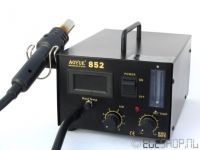SMD Soldering equipment
Soldering SMD components is not a real challenge once you have the right equipment. You need a iron with a small tip and a good temperature control. Please note that the temperature control is very important since the tip of your soldering iron will become unusable if it is too long too hot.
Again, Eleshop proved to be a nice source. They have a € 30,- soldering station but that one has no temperature indication so I decided to go for the version with LED display (the Aoyue 937) - at € 50,- still not expensive. Chinese stuff - yes - and most likely not as good as a Weller station but the Weller one would cost me around € 300,- so I am gambling (Chinese roulette).
up to now I am quite happy with the results. The soldering tips slide directly over the ceramic heating element, not quite what I am used from the Weller stations that I used and it does mean that it takes some time for the tip to become at working temperature. Of course this also limits the use for the heavier work.
But let's not forget this is an SMD soldering station. I found this to be a good all-round soldering station for the electronics hobbyist. It will even solder the thin tin cases that are used for shielding RF circuits without any problem but it takes some time for the soldering joints to flow nicely.
Compared to the WSD81 it takes longer for the tip to become at operating temparature, you will not be able to do the heavier soldering jobs and changing the tip is not as easy as with the Weller station. But let's be frank; comparing a € 50,- 45 W station againt a € 300,- 80W station is unfair ...
If you are a HAM radio hobbyist and you mostly build RF circuits then you might be better of with one of the more powerfull (70W) stations instead. But then be prepared to pay up to € 80,- (yes, that low!).
Hot air
The 937 is nice for mounting or replacing one or two components but for soldering a complete SMD board a hot air soldering station is more suitable. If you ever plan to solder SMD ICs then a hot air soldering station is a must.
Expensive stuff, not affordable for the hobbyist with a budget?
No, not at all expensive. Eleshop, becoming my preferred supplier, sells the Aoyue 852. A sub € 100,- solution that does the job. I think the lowest air flow could be a bit less but after having used it on a few boards I am getting used to it.
Start at something like 20 cm from the board to preheat the board and then, in circular movements, move down until the soldering paste starts to melt.
Watching the components float into place is fun!
Results
The results are great.
here is a photo of the first result. A thin strip of paste over the pads is all it takes.
After that it's just a matter of carfully pre-heating the board by brushing over the board with the hot air gun and after about 20 seconds I start applying direct heat to the leads of the chip.
All I did afterwards is to clean the board with an isopropane alcohol to remove any residual flux - but that is actually just for cosmetic purposes since the flux is a non corrosive type and cleaning is not neccessary.
Preheater plate

The next thing on my list to buy.
Instead of pre heating with the hot air station I'd like to have a preheater for even more professional results.
Using a pre heater plate means that the PCB will be heated from the bottom, up to a temperature just below the melting temperature of the soldering paste, and then you only need a little bit of hot air to finish the real soldering work.
Pre heating also means that you slowly heat the board and components and also slowly cool down the board and components. This prevents any possible problems like warping of the board or stress in soldering joints resulting in faults when the boards age.



